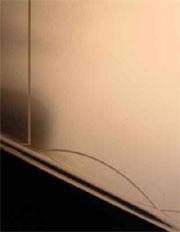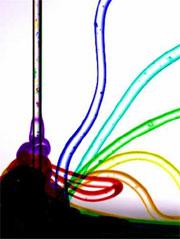 VIDEO Watch liquid hand soap bouncing up in a video taken at 50 frames per second here. Or download videos of jets using a high speed camera: one stream of liquid launches off from a pile here, and another bounces off from a soap film here.Credit: Michel Versluis
VIDEO Watch liquid hand soap bouncing up in a video taken at 50 frames per second here. Or download videos of jets using a high speed camera: one stream of liquid launches off from a pile here, and another bounces off from a soap film here.Credit: Michel VersluisDutch researchers believe they have cracked the physics behind a mysterious bouncing behaviour of liquids, first seen more than 40 years ago.
British engineer Arthur Kaye first noticed this weird phenomenon in 1963, while experimenting with a mixture of obscure organic liquids. When he poured his viscous mixture on to a surface, the down-going stream would suddenly throw up a jet that merged with the incoming stream.
"The effect is used in textbooks to illustrate the strange properties of complex fluids," says Michel Versluis of the University of Twente in the Netherlands. Now he and his colleagues say this odd phenomenon may actually be very common, occurring regularly in the bathroom and the kitchen1. It could happen with everything from tomato ketchup to yoghurt, paints, shampoo and liquid soap, Versluis says.
The reason you have probably never noticed this so-called Kaye effect is that it is generally over in an instant. The whole process, from the emergence of the jet to its merging with the incoming stream, typically takes about 300 milliseconds, says Versluis. "It's usually so short that you don't see it with the naked eye."
He and his colleagues have studied the Kaye effect using a high-speed video camera, which has allowed them to figure out what is really going on (see video clips, above).
Paint thinner
“It's a very simple experiment.”
Michel Versluis,
University of Twente, the Netherlands.
Versluis says the effect should happen in any liquid that displays shear-thinning behaviour. This means that as the liquid flows, its viscosity decreases; that is, it gets thinner. "Liquid soaps and shampoos are designed to have this property," says Versluis -they'll sit in your hand but will flow as you rub them into your hair. Non-drip paints have the same behaviour.
Pouring a column of these viscous liquids on to a surface initially creates a coiled heap. But at some point the stream slides down the side of the heap. A thin layer of shear-thinned liquid acts as a kind of lubricant between the two, preventing them from mixing.
The stream may then spring up from a dimple on the surface of the heap, just as an Olympic ski-jumper leaps from the lip of a ramp. The researchers' video images show a kind of U-shaped stream launching off the surface.
 This illustration gathers together several time-lapse snaps of a jet, with each time slice in a different colour.Credit: Michel Versluis
This illustration gathers together several time-lapse snaps of a jet, with each time slice in a different colour.Credit: Michel VersluisIt was previously thought that the Kaye effect was a kind of reflection, like a ball bouncing off a wall, and that the incoming jet had to strike a solid surface in order for an outgoing jet to form. But Versluis and colleagues have found that all that is needed is the lubrication provided by shear-thinning. They have even seen the Kaye effect for a liquid column poured on to a soap film, which dimples like a trampoline as the stream hits it.
Bouncing bridges
Versluis and his co-workers have also found a way to make the effect persistent. All it takes is to pour the stream on to a sloping surface: this can set up a cascade of arching jets that leap down the slope like a series of smaller and smaller bridges. The arcs will remain stable for as long as you keep pouring the liquid.
"It's a very simple experiment; you can do it in the bathroom," says Versluis. He advises that the liquid be poured from a height of around 20 cm, with a jet thickness of around 0.4 mm. It may be tricky, but it should be possible.
ADVERTISEMENT
The researchers haven't yet identified any applications of the effect, but they are intrigued by the way that a laser beam shone into the descending stream will stay inside it throughout the bounces, as though captured by a liquid optical fibre. "You can transport light this way," says Versluis.
Visit our ofleapingliquidsolve.html">newsblog to read and post comments about this story.
University of Twente, the Netherlands.
-
References
- Versluis M., et al. Preprint, http://www.arxiv.org/abs/physics/0603183 (2006).
- Kaye A., et al. Nature, 197. 1001 - 1002 (1963). | Article |
